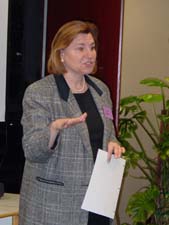Words of Wisdom: Teaching CML's Five Key Questions
|
Tessa Jolls shares words of wisdom at a teacher in-service day. |
By Tessa Jolls
The following reflections come from over two decades of CML's work and experience in the field of media literacy education. We share them both as an inspiration and a challenge as you explore yourself and then introduce your students to the Five Key Questions That Can Change the World!
- To teach, one must first understand. Teachers interested in media literacy need to explore and internalize for themselves the Five Core Concepts of media literacy. This foundation, in turn, provides the ability to convey and illuminate the Five Key Questions for students. Applying the Five Key Questions then gives students the tools with which to negotiate meaning for themselves.
- Developing a common vocabulary around media literacy within classes, and within overall teaching and learning communities, is essential. Once there is a common understanding of the Five Core Concepts and Five Key Questions, progress in applying media literacy is rapid.
- Media literacy is a skill and teaching it is different than teaching factual knowledge. Media literacy provides a process for learning - the process of inquiry - which can be applied to any content or subject area. The Five Key Questions are a starting point but it takes repeated practice of applying the questions to different media and in a variety of activities to really master the process. It's like learning to tie your shoes or ride a bike - you usually don't "get it" the first time. Becoming media literate takes practice, practice, practice!
- When you hear the classic definition: "media literacy involves learning to access, analyze, evaluate and create media in a variety of forms," it seems overwhelming. Where do you start? But if the focus of media literacy instruction becomes introducing and reinforcing the use of the Five Key Questions, teachers have an immediate entry point. Plus it's a handy way to make connections to the curricula you are already working with in other subject areas.
- The Five Key Questions are the focal point of learning the media literacy process for students. Why? Because learning to apply Five Key Questions is doable and engaging. Students like to 'pull back the covers' and see what's behind media messages -- and they enjoy expressing their own point of view.
- After a while, familiarity with the Five Key Questions becomes like shorthand. Students point out, 'That's #1!,' or 'That's # 4!' It's fun for them to quickly discern how messages are created, the impact they have and how they are received, and to share their insights with others.
- Some teachers immediately make the connections between media literacy and other subject areas. Others need more time to work with the Core Concepts and Key Questions. Generally, it takes about a year for teachers to feel confident about teaching media literacy - and by then, their teaching is transformed forever.
- Citizens of all ages would benefit from knowing the Five Core Concepts and Five Key Questions of Media Literacy. They are a fundamental skillset for participants in a democratic society.
-- from Five Key Questions That Can Change the World,
Part II of the CML MediaLit Kit developed and published
by the Center for Media Literacy / www.medialit.net



